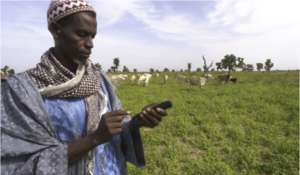Web applications, software, robots, drones …, digital is spreading at high speed on the continent, improving the technico-economic performance of the agricultural sector. Will Information and Communication Technologies (ICT) enable Africa to lead its Green Revolution?

At the farm level
Africa shows the lowest agricultural yields in the world. This can be explained, amongst other reasons, by the low levels of education and training of farmers as wall by the low number of extension workers (In 2011, Africa counted one extension worker for 4,000 farmers compared to 1 for 200 in developed countries[1]). By providing farmers with training adapted to an immediate productivity gain, ICTs could become the first African extension worker. The concept has been proven by several platforms, such as iCow in Kenya that increased the milk production of its users by 30%[2] or Digital Green in Ethiopia already used by nearly 400,000 farms[3].
ICTs, through sensors and various connected tools, invade farms in the West and conquer the continent progressively via the Maghreb and its southern part. They collect, process, store and disseminate data for endless possibilities of use ranging from piloting farms to a global observatory of agricultural production. The data collected by satellite or by drone (more precise scale) enable to establish a plot map and to measure their water, nitrogen and biomass needs. Thus, the application of inputs is done, according to the principles of precision farming. This means according to the real needs of the parcel, limiting the environmental impacts and improving the economic performances.
The abundance of available data analyzed by predictive models also accompanies the farmer with an incredible precision in his management of climatic, health, but also economic and environmental risks. The farmer detects problems early (lack of water, need for pesticides), so he can answer them earlier. Weather forecasts allow him to better plan the work in the fields and to avoid climatic risks as much as possible (freezing after sowing, rain before treatment, etc.).
ICT also includes all robotics technologies and automatic controls found at all levels of agricultural production. These technologies aim to reduce the hardness of the farmer’s work and / or free time (Gain from 2 to 3 hours of work per day). Connected tractors, for example, are guided by satellite and allow plowing, mowing and harvesting, optimizing space and movement in the field. On their side, the drones allow to spray automatically and in inaccessible areas. They can also be used to monitor a herd on their pasture.
The use of artificial intelligence also appears, particularly with the Pix Fruit project, co-developed by CIRAD and the Senegalese Institute for Agricultural Research, which estimates the production of mangoes from photos taken on the application. This system enables to reduce the margins of error in the calculation of production and thus to increase the income of the producer, the production being often estimated beforehand by the buyer.
At the sector level
Thanks to ICT, African farmers are connected with market prices for the purchase of their inputs or the sales of their products. In many countries of the continent, Esoko allows farmers to choose between several markets and receive offers for their products. According to McKinsey, Esoko members saw their revenues grow by more than 20%.
ICTs also facilitate contracting agriculture by allowing producers to be identified with a simple mobile phone. Basic applications can manage a farmer’s register, send them grouped messages and follow the procurement / billing processes. This mobile identification system has been used to fight corruption in subsidized fertilizer distribution. Before using its e-portfolio program, only 11% of Nigerian farmers had access to the subsidy system. Since 2012, they receive all their vouchers by phone with the name of the nearest dealer.
Given the high health stakes and the complexification of agro-food production chains, the opportunities that ICTs allow to improve the traceability of agricultural products are timely. Many software programs, much based on blockchain technology, appear to trace the life story of a product from field to plate and to assess the distribution of added value. For example, SAP’s Africa agriculture business is developing solutions to monitor each steps of the production, focusing on a particular sector by country (Eg: rice in Ivory Coast, maize in Ghana, potato in Kenya ..) .
Finally, at the global level, the World Bank created in 2018 an Observatory of Agriculture, which collects and shares agrometeorological data to detect crop risks and avoid famines.
New technologies are a powerful lever for increasing economic, environmental and social performance. Will they allow Africa to meet its major food challenge?
[1] https://www.scidev.net/afrique-sub-saharienne/cultures/actualites/les-tic-pour-combler-les-lacunes-de-la-vulgarisation-en-agriculture.html
[2] http://classe-export.com/index.php/actus/24940-nouvelles-technologies-developpent-commerce-sante-lagriculture-afrique/